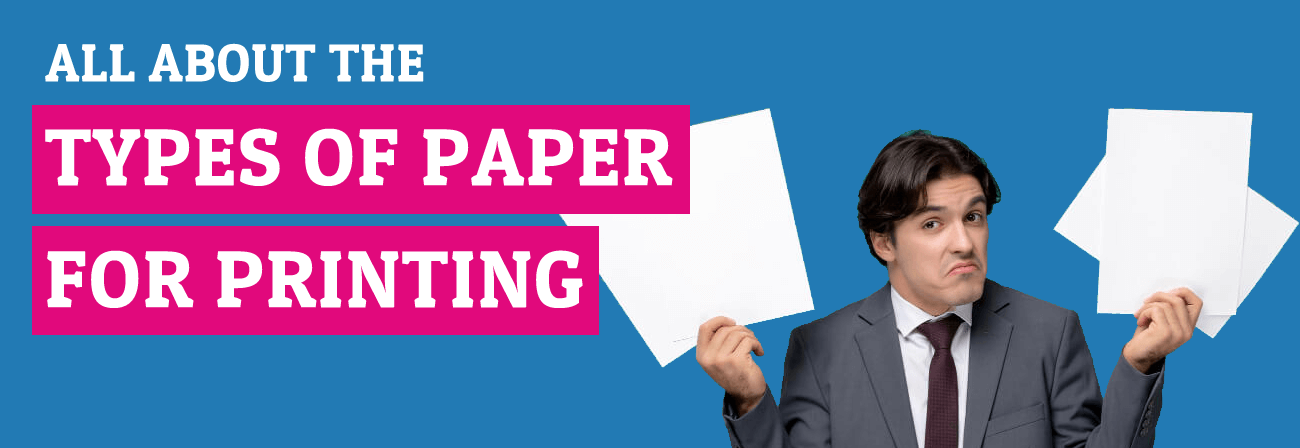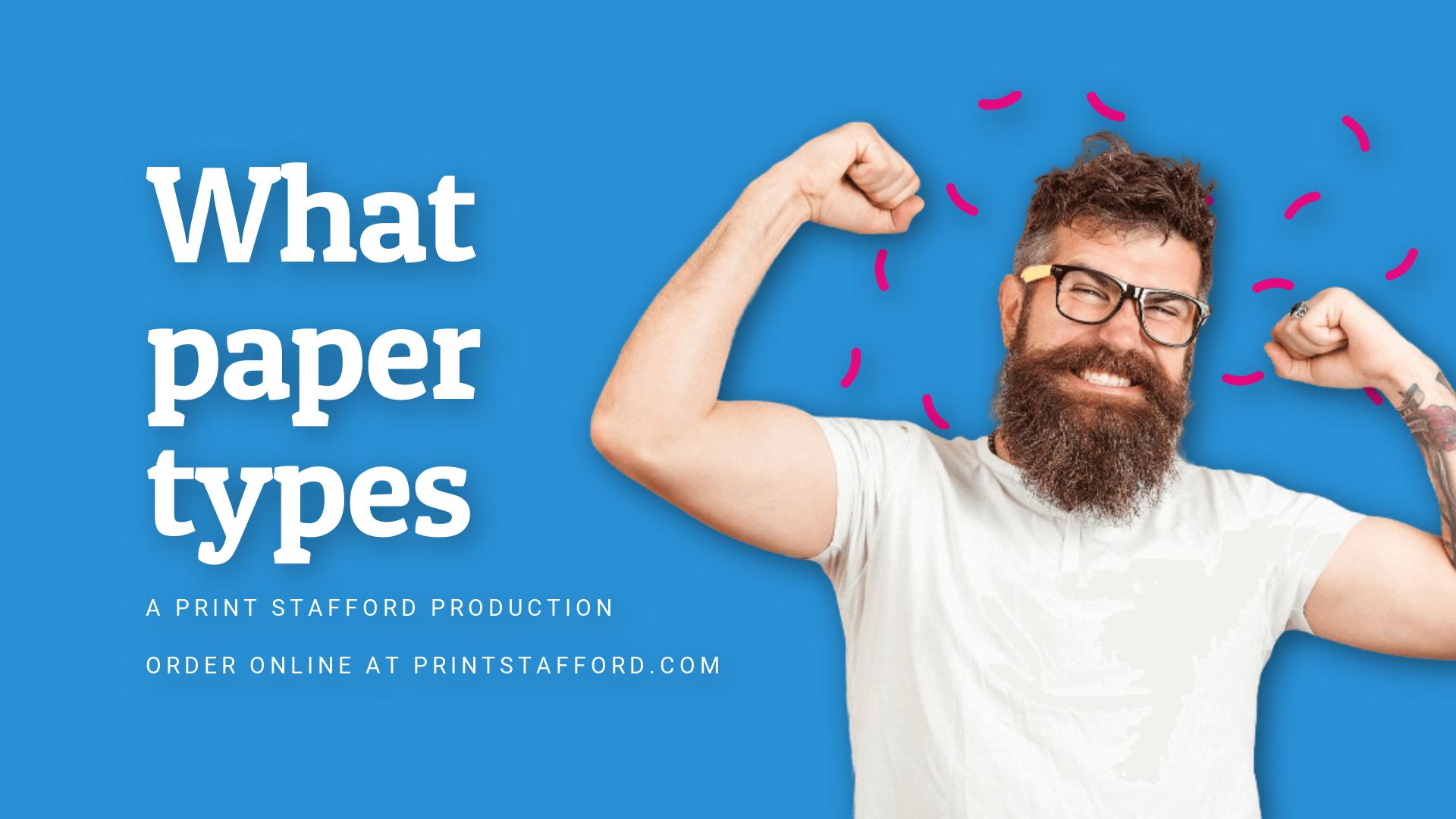Free nationwide shipping on all orders!
Simply, Affordable, Quality Print & Design in Staffordshire and the UK
Free nationwide shipping on all orders!
Simply, Affordable, Quality Print & Design in Staffordshire and the UK

Paper. We all know what it is and what it can do, so why is it so easy to get lost when it comes to choosing from the various papers for printing? Well, we wrote this guide so you can stop getting confused.
Now more than ever, there are a multitude of different paper types ideal for printing, each boasting its own set of benefits. The sheet of paper stock you use for your new set of Letterheads should differ from the weight of paper you use for your Business Cards and other printed documents.
To help you find out which of the common paper types best suits your printing needs, keep reading… we are going to help you get a better understanding by sharing our knowledge. This will ensure you are selecting the best paper for your needs.
Choosing from the many different types of paper available can be confusing we are going to cover the papers used for printing your design so you don’t order the wrong type of paper.
Uncoated Paper – Just as the name suggests, uncoated paper has no coating on at all and is as naked as the paper you’d find in your office printer this is sometimes referred to as bond paper. There are many weights or types of bond paper available. Uncoated paper is the most popular in the range of paper types. This paper is usually used as copier paper or headed paper and in everyday printing.
The uncoated and natural finish of this stock can make the brightness of the paper stand out and this paper is the perfect go-to choice for printing documents or headed paper as it allows for either overprinting or the ability to be written on easier than when the paper is coated.
Silk-Coated or Matte Paper – Falling in the middle of gloss and matte paper, silk-coated paper has a smooth, silky coating. It is incredibly silky to the touch but leaves no shine or reflective finish. This is probably the most commonly used paper available on the market today and this paper is a popular choice for those looking to carry a professional image with their printed designs.
Gloss Coated Paper – This used to be the most popular among the many types of paper. It was typically used on flyers and brochures, gloss paper comes with a wonderfully shiny coating for the ultimate professional finish. Although nowadays Silk is more commonly used over glossy paper due to the costs and versatility of the finishing options. Glossy paper is typically used for takeaway menus and the like where the beautiful menu choices are printed onto the paper.
As we’ve already outlined above, matte and gloss-coated paper differ in their finish. Matte paper is finished, with a non-reflective look while gloss-coated paper demands attention with a wonderful shine. But what are the pros and cons of each?
Silk paper is wonderfully versatile, and many argue its simplistic, matte finish is more contemporary and on-trend. Since it has no reflective coating, it reduces the risk of fingerprint marks. Our silk papers are available with a range of different types of finishes as standard not available in our gloss paper stocks.
Let’s have a look at the different types of finishing available, we can offer 3 types of lamination, matt, soft-touch and gloss. Why gloss when we have gloss paper we hear you say. Well, our silk papers are available with a larger range of thicker papers. This means that our silk paper features are commonly used for printed booklets or brochures as they allow for the inner or outer paper layers to have the same consistent finish. For example, we always recommend we suggest inside pages of books be of 150gsm silk and the cover paper be 250gsm silk.
Adding this thin cardstock paper can be used to make a product with a very prestigious feel. That is not to say that this is the only choice as it’s very dependent on the finish and use of the finished product.
On the other hand, gloss paper is incredibly satisfying to hold and view. With its glossy finish, the paper is designed to attract attention, especially if your print has large imagery or bold colours included. We see this used commonly for takeaway menus and mail drops. Within the commercial printing industry, the range of glossy papers is not as wide as our silk range although we carry 130gsm and 170gsm Gloss as standard.
Before we continue explaining the benefits of the different types of paper, let’s take a quick detour and learn how paper is made. Paper is produced using dried, compressed sheets of plant fibres. The cellulose fibres come from plants and trees, usually fast-growing evergreen conifers, which are then pressed together to form a strong, flexible sheet.
The paper is then treated with various industry finishes and sold from paper mills to many businesses across the sector. Some are delivered as sheets so you can buy them in the supermarket. Whereas we purchase sheets and rolls for the many different types of machines we use. We do not stock every paper on the market and we only use paper that’s from FSC-supplied paper merchants.

There are many common types of paper and we will go into that very shortly. Firstly we will quickly outline the common paper thicknesses and their uses as the thickness of the paper may affect the available type of paper you need.
Here’s a quick list of some of our most popular printing products and the types of paper and paper finishes available on them. This is meant as a guide and really depends on your budget and the finish you are looking for in your finished print product.
Business Stationery – Prints such as letterheads, forms and compliment slips will typically be printed on uncoated stocks ranging from 90gsm to 170gsm.
Flat Leaflets & Flyers – We offer our leaflets in a range of stocks, such as silk, gloss, uncoated and many creative stocks. We can print flyers from 130gsm gloss all the way to 450gsm silk stock for a really high-end luxury finish.
Folded Leaflets and flyers – These are available in a choice of silk, gloss and creative stocks. Again these can range from 130gsm gloss all the way to 450gsm silk stock for a luxury finish.
Business Cards – We offer our business cards typically on 450gsm because we think it’s the perfect thickness. This stock is not suitable for all finishes and scenarios so we also offer them printed from 350gsm uncoated
Recycled Papers – Our recycled paper stocks are the same quality as our standard stocks. They can be used for all sorts of printing needs including flyers, leaflets, letterheads and more. Ranging from different thicknesses from 120gsm uncoated to 350gsm uncoated all of our recycled papers aim to be carbon balanced.
What’s with all the numbers? Typically the larger the number the heavier the paper. The weight of the paper is a great way to set yourself apart from the competition. We even wrote a guide to printer paper weights.
Tissue Paper – Those in the hospitality sector will find many great uses for tissue paper. This paper type is highly absorbent and soft and is often used to manufacture handkerchiefs or napkins. Restaurants, hotels and cafés can easily establish their brand identity with napkins printed with their logo or dyed in their brand colours.
Card Stock – We guarantee you’ll have had your hands on plenty of card stock since it is one of the most commonly used paper types for businesses. It is sturdy, strong and used widely for printing business cards, postcards and catalogue covers. It is significantly thicker than typical paper stock and promises a longer life span, making it ideal for stationery and other printing goods that are frequently passed around.
Cardboard – Your recycle bin is probably full of it, but cardboard can be an invaluable paper type for printing. Cardboard is comprised of three layers of paper with a corrugated inner layer that delivers its characteristic strength. It is lightweight, durable and perfect for affordable sign printing.
Recycled Paper – With more and more businesses trying to reduce their environmental impact, recycled paper has become another increasingly popular choice. It is made from reused paper products and is believed to use around 70% less energy and water compared to making new paper from trees.
Outside of the commercial printing processes paper is also available as tracing papers (although we do not offer this). Within the different types of printer paper or copy paper that you can back from the high street, there are various inkjet papers and photo papers. Most supermarkets now carry this cheapest bulk paper product although naturally, we would prefer you to use our paper for your project.
We’ve said it before, and we’ll say it again. The best types of paper used for your printing project depend entirely on your needs, your business and your budget. Businesses looking to demand attention and emit a real sense of professionalism may prefer silk-coated paper with a range of finishes while an eco-friendly corporate entity might prefer a 160gsm uncoated letterhead.
If you are still unsure about the different types of printing paper and which is best for your business, the Print Stafford team is here to help. We even wrote about the different sizes of paper available. Perhaps you would prefer to read about the differences between Digital Printing and Litho printing?
Get in touch to let us know what you are looking for and we will happily point you in the right direction. If you need assistance with your graphic design too, we also have a great in-house design team ready to help bring your printing project to life!
